2018 Hyundai Creta tow
[x] Cancel search: towPage 356 of 472
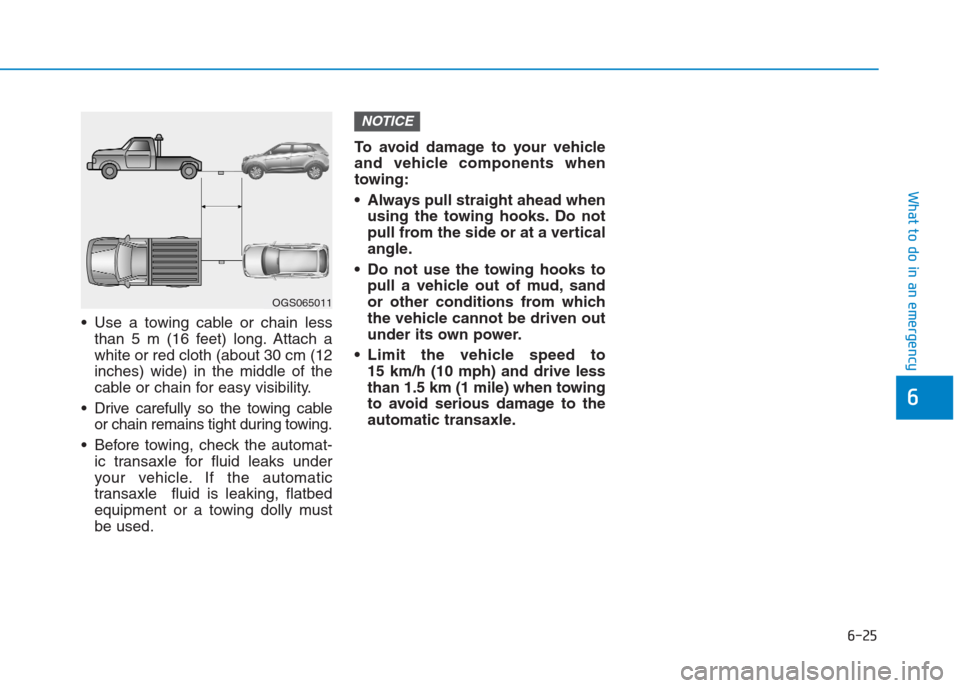
6-25
What to do in an emergency
6
Use a towing cable or chain less
than 5 m (16 feet) long. Attach a
white or red cloth (about 30 cm (12
inches) wide) in the middle of the
cable or chain for easy visibility.
Drive carefully so the towing cable
or chain remains tight during towing.
Before towing, check the automat-
ic transaxle for fluid leaks under
your vehicle. If the automatic
transaxle fluid is leaking, flatbed
equipment or a towing dolly must
be used.To avoid damage to your vehicle
and vehicle components when
towing:
Always pull straight ahead when
using the towing hooks. Do not
pull from the side or at a vertical
angle.
Do not use the towing hooks to
pull a vehicle out of mud, sand
or other conditions from which
the vehicle cannot be driven out
under its own power.
Limit the vehicle speed to
15 km/h (10 mph) and drive less
than 1.5 km (1 mile) when towing
to avoid serious damage to the
automatic transaxle.
NOTICE
OGS065011
Page 357 of 472
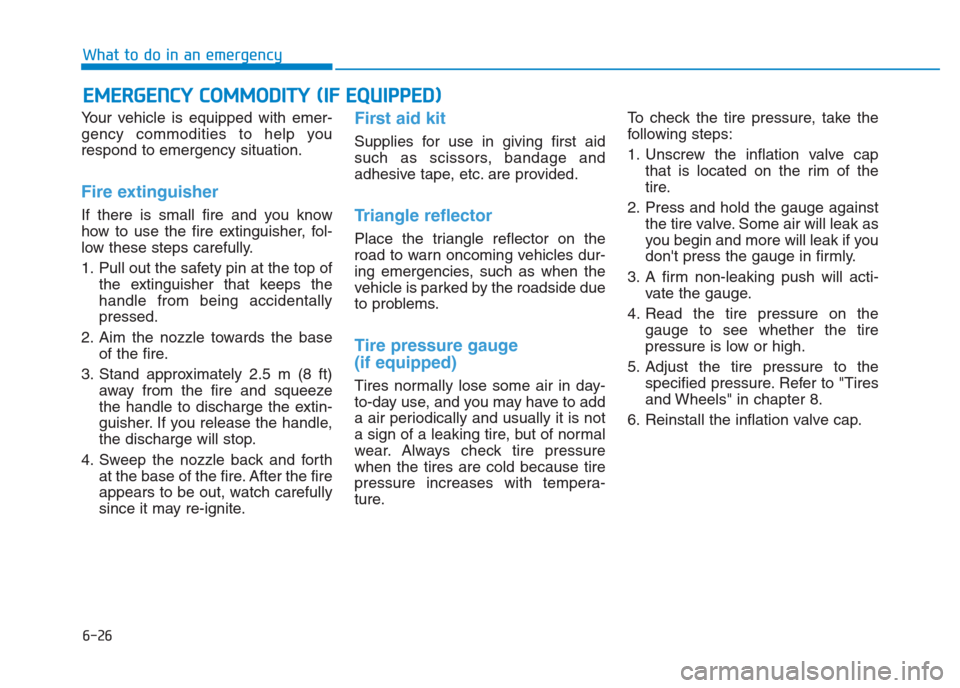
Your vehicle is equipped with emer-
gency commodities to help you
respond to emergency situation.
Fire extinguisher
If there is small fire and you know
how to use the fire extinguisher, fol-
low these steps carefully.
1. Pull out the safety pin at the top of
the extinguisher that keeps the
handle from being accidentally
pressed.
2. Aim the nozzle towards the base
of the fire.
3. Stand approximately 2.5 m (8 ft)
away from the fire and squeeze
the handle to discharge the extin-
guisher. If you release the handle,
the discharge will stop.
4. Sweep the nozzle back and forth
at the base of the fire. After the fire
appears to be out, watch carefully
since it may re-ignite.
First aid kit
Supplies for use in giving first aid
such as scissors, bandage and
adhesive tape, etc. are provided.
Triangle reflector
Place the triangle reflector on the
road to warn oncoming vehicles dur-
ing emergencies, such as when the
vehicle is parked by the roadside due
to problems.
Tire pressure gauge
(if equipped)
Tires normally lose some air in day-
to-day use, and you may have to add
a air periodically and usually it is not
a sign of a leaking tire, but of normal
wear. Always check tire pressure
when the tires are cold because tire
pressure increases with tempera-
ture.To check the tire pressure, take the
following steps:
1. Unscrew the inflation valve cap
that is located on the rim of the
tire.
2. Press and hold the gauge against
the tire valve. Some air will leak as
you begin and more will leak if you
don't press the gauge in firmly.
3. A firm non-leaking push will acti-
vate the gauge.
4. Read the tire pressure on the
gauge to see whether the tire
pressure is low or high.
5. Adjust the tire pressure to the
specified pressure. Refer to "Tires
and Wheels" in chapter 8.
6. Reinstall the inflation valve cap.
E EM
ME
ER
RG
GE
EN
NC
CY
Y
C
CO
OM
MM
MO
OD
DI
IT
TY
Y
(
(I
IF
F
E
EQ
QU
UI
IP
PP
PE
ED
D)
)
What to do in an emergency
6-26
Page 367 of 472
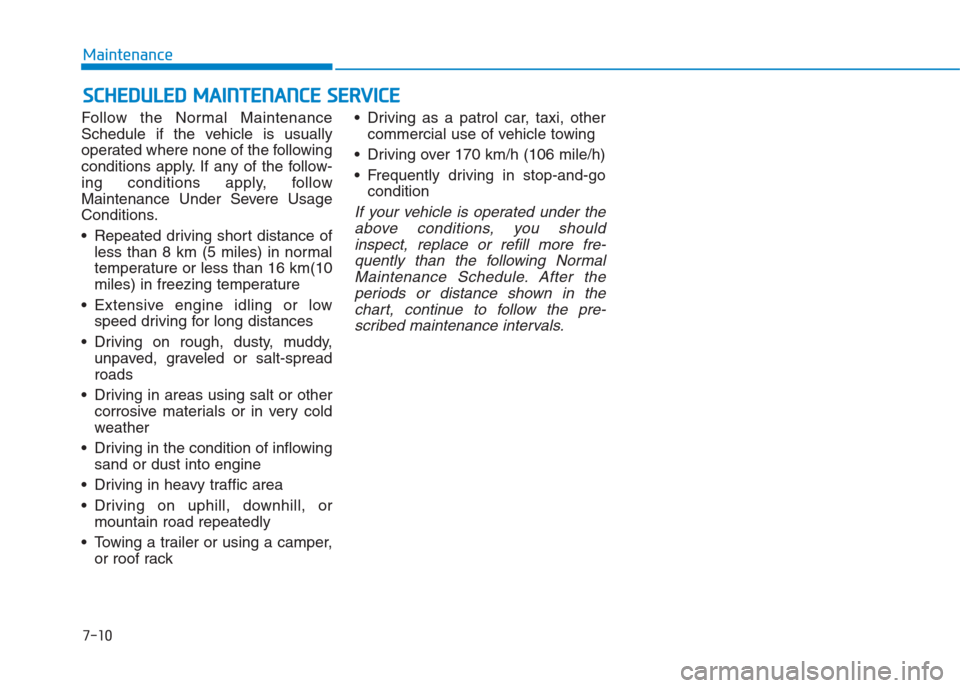
7-10
Maintenance
S SC
CH
HE
ED
DU
UL
LE
ED
D
M
MA
AI
IN
NT
TE
EN
NA
AN
NC
CE
E
S
SE
ER
RV
VI
IC
CE
E
Follow the Normal Maintenance
Schedule if the vehicle is usually
operated where none of the following
conditions apply. If any of the follow-
ing conditions apply, follow
Maintenance Under Severe Usage
Conditions.
Repeated driving short distance of
less than 8 km (5 miles) in normal
temperature or less than 16 km(10
miles) in freezing temperature
Extensive engine idling or low
speed driving for long distances
Driving on rough, dusty, muddy,
unpaved, graveled or salt-spread
roads
Driving in areas using salt or other
corrosive materials or in very cold
weather
Driving in the condition of inflowing
sand or dust into engine
Driving in heavy traffic area
Driving on uphill, downhill, or
mountain road repeatedly
Towing a trailer or using a camper,
or roof rack Driving as a patrol car, taxi, other
commercial use of vehicle towing
Driving over 170 km/h (106 mile/h)
Frequently driving in stop-and-go
condition
If your vehicle is operated under the
above conditions, you should
inspect, replace or refill more fre-
quently than the following Normal
Maintenance Schedule. After the
periods or distance shown in the
chart, continue to follow the pre-
scribed maintenance intervals.
Page 373 of 472
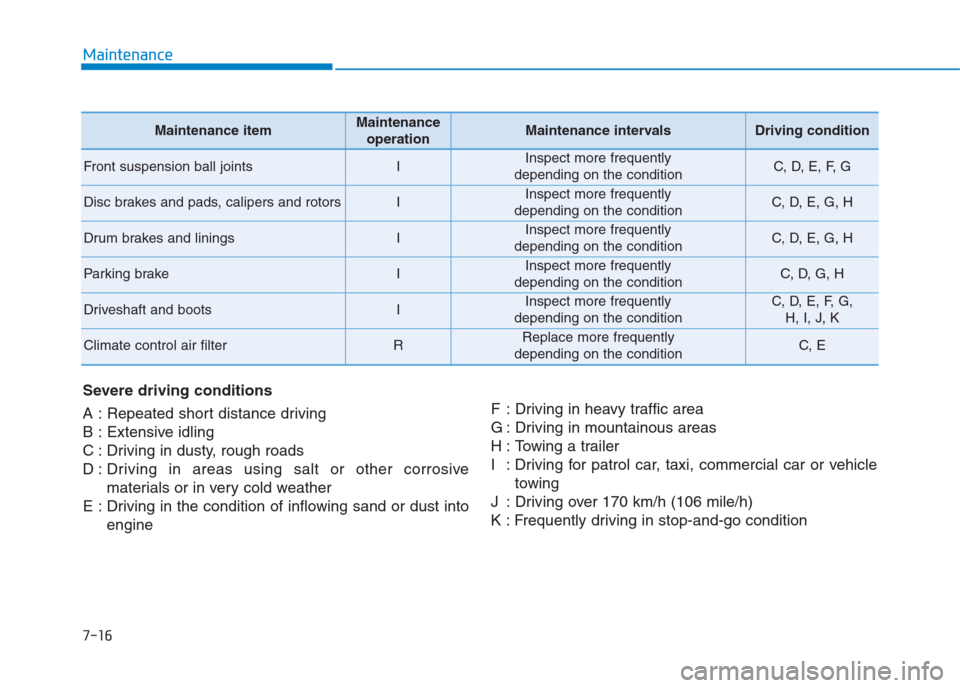
7-16
Maintenance
Severe driving conditions
A : Repeated short distance driving
B : Extensive idling
C : Driving in dusty, rough roads
D : Driving in areas using salt or other corrosive
materials or in very cold weather
E : Driving in the condition of inflowing sand or dust into
engineF : Driving in heavy traffic area
G : Driving in mountainous areas
H : Towing a trailer
I : Driving for patrol car, taxi, commercial car or vehicle
towing
J : Driving over 170 km/h (106 mile/h)
K : Frequently driving in stop-and-go condition
Maintenance itemMaintenance
operationMaintenance intervalsDriving condition
Front suspension ball jointsIInspect more frequently
depending on the conditionC, D, E, F, G
Disc brakes and pads, calipers and rotorsIInspect more frequently
depending on the conditionC, D, E, G, H
Drum brakes and liningsIInspect more frequently
depending on the conditionC, D, E, G, H
Parking brakeIInspect more frequently
depending on the conditionC, D, G, H
Driveshaft and bootsIInspect more frequently
depending on the conditionC, D, E, F, G,
H, I, J, K
Climate control air filterRReplace more frequently
depending on the conditionC, E
Page 378 of 472
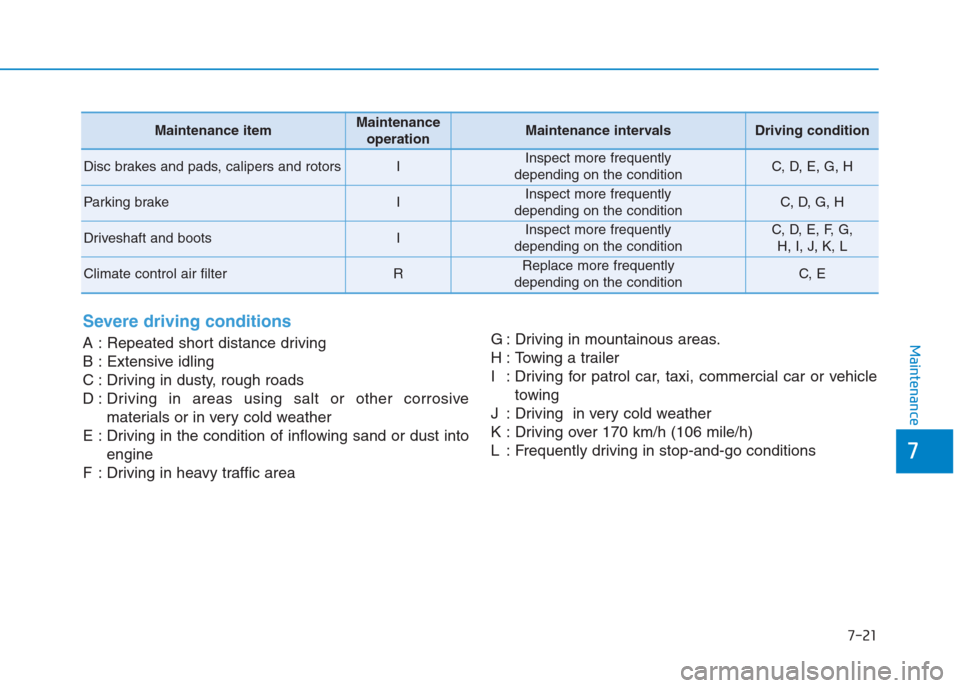
7-21
7
Maintenance
Severe driving conditions
A : Repeated short distance driving
B : Extensive idling
C : Driving in dusty, rough roads
D : Driving in areas using salt or other corrosive
materials or in very cold weather
E : Driving in the condition of inflowing sand or dust into
engine
F : Driving in heavy traffic areaG : Driving in mountainous areas.
H : Towing a trailer
I : Driving for patrol car, taxi, commercial car or vehicle
towing
J : Driving in very cold weather
K : Driving over 170 km/h (106 mile/h)
L : Frequently driving in stop-and-go conditions
Maintenance itemMaintenance
operationMaintenance intervalsDriving condition
Disc brakes and pads, calipers and rotorsIInspect more frequently
depending on the conditionC, D, E, G, H
Parking brakeIInspect more frequently
depending on the conditionC, D, G, H
Driveshaft and bootsIInspect more frequently
depending on the conditionC, D, E, F, G,
H, I, J, K, L
Climate control air filterRReplace more frequently
depending on the conditionC, E
Page 384 of 472
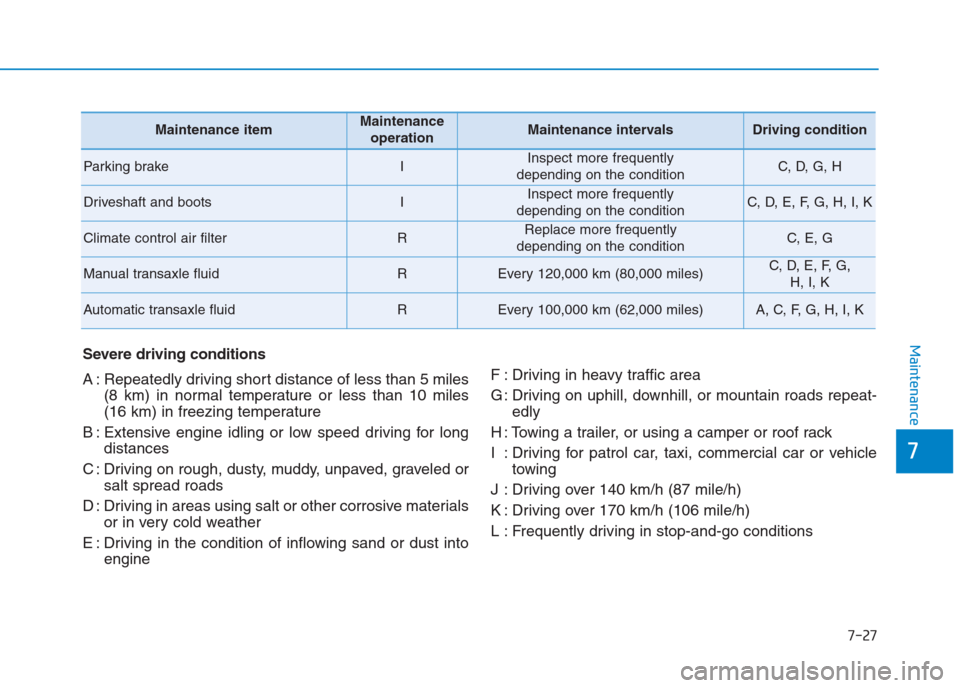
7-27
7
MaintenanceSevere driving conditions
A : Repeatedly driving short distance of less than 5 miles
(8 km) in normal temperature or less than 10 miles
(16 km) in freezing temperature
B : Extensive engine idling or low speed driving for long
distances
C : Driving on rough, dusty, muddy, unpaved, graveled or
salt spread roads
D : Driving in areas using salt or other corrosive materials
or in very cold weather
E : Driving in the condition of inflowing sand or dust into
engineF : Driving in heavy traffic area
G : Driving on uphill, downhill, or mountain roads repeat-
edly
H : Towing a trailer, or using a camper or roof rack
I : Driving for patrol car, taxi, commercial car or vehicle
towing
J : Driving over 140 km/h (87 mile/h)
K : Driving over 170 km/h (106 mile/h)
L : Frequently driving in stop-and-go conditions
Maintenance itemMaintenance
operationMaintenance intervalsDriving condition
Parking brakeIInspect more frequently
depending on the conditionC, D, G, H
Driveshaft and bootsIInspect more frequently
depending on the conditionC, D, E, F, G, H, I, K
Climate control air filter RReplace more frequently
depending on the conditionC, E, G
Manual transaxle fluidREvery 120,000 km (80,000 miles)C, D, E, F, G,
H, I, K
Automatic transaxle fluidREvery 100,000 km (62,000 miles)A, C, F, G, H, I, K
Page 391 of 472

7-34
Maintenance
E EN
NG
GI
IN
NE
E
C
CO
OO
OL
LA
AN
NT
T
The high-pressure cooling system
has a reservoir filled with year-round
antifreeze coolant. The reservoir is
filled at the factory.
Check the antifreeze protection and
coolant level at least once a year, at
the beginning of the winter season,
and before traveling to a colder cli-
mate.
Do not drive with no engine
coolant. It may cause water
pump failure and engine seizure,
etc.
When the engine overheats from
low engine coolant, suddenly
adding engine coolant may
cause cracks in the engine. To
prevent damage, add engine
coolant slowly in small quanti-
ties.Checking the coolant level
NOTICE
Removing radiator
cap
Never attempt to remove the
radiator cap while the engine
is operating or hot. Doing so
might lead to cooling system
and engine damage and could
result in serious personal
injury from escaping hot
coolant or steam.
(Continued)
WARNING
(Continued)
Turn the engine off and wait
until it cools down. Use
extreme care when removing
the radiator cap. Wrap a thick
towel around it, and turn it
counterclockwise slowly to
the first stop. Step back while
the pressure is released from
the cooling system. When you
are sure all the pressure has
been released, press down on
the cap, using a thick towel,
and continue turning counter-
clockwise to remove it.
Even if the engine is not oper-
ating, do not remove the radi-
ator cap or the drain plug
while the engine and radiator
are hot. Hot coolant and
steam may still blow out
under pressure, causing seri-
ous injury.
OGS076105
Page 472 of 472

I-8
Tire specification and pressure label ..............................8-9
Tires and wheels....................................................7-51, 8-4
Checking tire inflation pressure.................................7-53
Low aspect ratio tire ..................................................7-61
Recommended cold tire inflation pressures ..............7-51
Tire care .....................................................................7-51
Tire maintenance .......................................................7-57
Tire replacement ........................................................7-55
Tire rotation ...............................................................7-54
Tire sidewall labeling.................................................7-57
Tire traction................................................................7-57
Wheel alignment and tire balance .............................7-55
Wheel replacement ...................................................7-56
Towing ..........................................................................6-22
Emergency towing ....................................................6-24
Removable towing hook ...........................................6-23
Towing service ...........................................................6-22
Vehicle certification label ...............................................8-8
Vehicle identification number (VIN)..............................8-8
Vehicle weight ..............................................................5-56
Overloading ...............................................................5-56Washer fluid ..................................................................7-39
Checking the washer fluid level ................................7-39
Windows .......................................................................3-19
Power windows..........................................................3-19
Winter driving...............................................................5-52
Snow or icy conditions ..............................................5-52
Winter precautions .....................................................5-54
Wiper blades .................................................................7-44
Blade inspection.........................................................7-44
Blade replacement .....................................................7-44
Wipers and washers ......................................................3-88
Rear window wiper and washer switch .....................3-90
Windshield washers ...................................................3-89
Windshield wipers .....................................................3-89
Index
V
W